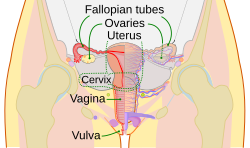Fallopian tube
From Wikipedia, the free encyclopedia
| It has been suggested that Oviduct be merged into this article or section. (Discuss) |
| Fallopian tube | |
|---|---|
 | |
| Schematic frontal view of female anatomy | |
 | |
| Vessels of the uterus and its appendages, rear view. (Fallopian tubes visible at top right and top left.) | |
| Latin | tuba uterina |
| Gray's | subject #267 1257 |
| Artery | tubal branches of ovarian artery, tubal branch of uterine artery |
| Lymph | lumbar lymph nodes |
| Precursor | Müllerian duct |
| MeSH | Fallopian+Tubes |
The Fallopian tubes, named after Gabriel Fallopius (Gabriele Falloppio), also known asoviducts, uterine tubes, and salpinges (singular salpinx) are two very fine tubes lined withciliated epithelia, leading from the ovaries of female mammals into the uterus, via the utero-tubal junction. In non-mammalian vertebrates, the equivalent structures are the oviducts.
Contents[hide] |
[edit]Anatomy and histology
The tube connects the ovary to the uterus as the egg passes through it in a woman's body. Its different segments are (lateral to medial): the infundibulum with its associated fimbriae near the ovary, the ampullary region that represents the major portion of the lateral tube, theisthmus which is the narrower part of the tube that links to the uterus, and the interstitial (also intramural) part that transverses the uterine musculature. The tubal ostium is the point where the tubal canal meets the peritoneal cavity, while the uterine opening of the Fallopian tube is the entrance into the uterine cavity, the utero-tubal junction.
There are two types of cells within the simple columnar epithelium of the Fallopian tube. Ciliated cells predominate throughout the tube, but are most numerous in the infundibulum and ampulla. Estrogen increases the production of cilia on these cells. Interspersed between the ciliated cells are peg cells, which contain apical granules and produce the tubular fluid. This fluid contains nutrients for spermatzoa, oocytes, and zygotes. The secretions also promote capacitation of the sperm by removing glycoproteins and other molecules from the plasma membrane of the sperm. Progesterone increases the number of peg cells, while estrogen increases their height and secretory activity. Tubal fluid flows against the action of the ciliae, that is toward the fimbrated end.
[edit]Function in fertilization
When an ovum is developing in an ovary, it is encapsulated in a sac known as an ovarian follicle. On maturity of the ovum, the follicle and the ovary's wall rupture, allowing the ovum to escape. The egg is caught by the fimbriated end and travels to the ampulla where typically the sperm are met and fertilization occurs; the fertilized ovum, now a zygote, travels towards the uterus aided by activity of tubal cilia and activity of the tubal muscle. After about five days the now embryo enters the uterine cavity and implants about a day later.
Occasionally the embryo implants into the Fallopian tube instead of the uterus, creating an ectopic pregnancy, commonly known as a "tubal pregnancy".
[edit]Patency testing
While a full testing of tubal functions in patients with infertility is not possible, tesing of tubal patency is important as tubal obstruction is a major cause of childlessness. A hysterosalpingogram will demonstrate that tubes are open when the radioopaque dye spills into the uterine cavity. Tubal insufflation is a office method to indicate patency. during surgery the status of the tubes can be inspected and a dye such asmethylene blue can be injected into the uterus and shown to pass through the tubes when the cervix is occluded.
[edit]Embryology and homology
Embryos have two pairs of ducts to let gametes out of the body; one pair (the Müllerian ducts) develops in females into the Fallopian tubes, uterus and vagina, while the other pair (the Wolffian ducts) develops in males into the epididymis and vas deferens.
Normally, only one of the pairs of tubes will develop while the other regresses and disappears in utero.
The homologous organ in the male is the rudimentary appendix testis.
[edit]Pathology
Pelvic inflammatory disease can strike the fallopian tubes. This might cause a Fallopian tube obstruction. Fallopian tube cancer is a rare neoplasm that can arise from the epithelial lining of the Fallopian tube. This cancer is sometimes misdiagnosed as ovarian cancer [1]. However, treatment of both ovarian and Fallopian tube cancer is similar.
[edit]Surgery
The surgical removal of a Fallopian tube is called a salpingectomy. To remove both sides is a bilateral salpingectomy. An operation that combines the removal of a Fallopian tube with removal of at least one ovary is a salpingo-oophorectomy. An operation to restore a fallopian tube obstruction is called a tuboplasty.
[edit]Etymology and nomenclature
They are named after their discoverer, the 16th century Italian anatomist, Gabriele Falloppio.
Though the name 'Fallopian tube' is eponymous, some texts spell it with a lower case 'f' from the assumption that the adjective 'fallopian' has been absorbed into modern English as the de facto name for the structure.
[edit]Additional images
[edit]See also
[edit]References
[edit]External links
- uterine+tube at eMedicine Dictionary
- Histology at BU 18501loa
| ||||||||||||||||||||||||||||||||||||||||||||||||||||||||||||||










No comments:
Post a Comment